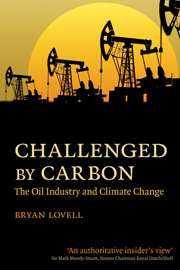
I'm reading Challenged by Carbon: The Oil Industry and Climate Change by Bryan Lovell.
Bryan Lovell is a geologist who has worked in academia and the oil industry for decades. This is an unusual book, intertwining two stories, one of them 55 million years old, and one less than 55 years old. I've not heard either story told before, and both are fascinating.
For the older, slower story, Dr Lovell delves into the details of the geological history of Iceland, the North Atlantic, and the North Sea. He describes how local heavings of the planet's stomach have caused a sub-ocean ridge between Scotland and Iceland to slightly rise and fall, having knock-on effects on ocean circulation and global climate; how slight variations in the average intensity of sunlight in the Northern hemisphere cause changes in climate on a timescale of 20,000 years which can be detected in sedimnetary rocks; and, crucially, how a large natural rapid release of carbon into the atmosphere, 55 million years ago, led to an enormous global warming event, raising the temperature of the water at the bottom of the ocean by more than 4 degrees C within roughly 10,000 years.
The younger, rapidly-moving story is the `insider's view' of how the oil industry, in the last 15 years, changed its mind about human-caused climate change. Starting from positions of climate inactivism (by which I mean "yeah, it may be true, but there's lots of uncertainty and there's no point doing anything, and we oppose greenhouse-gas-reduction treaties") or outright denial, the big oil companies, driven by the science, changed their tunes. First, in 1997, Shell and BP, then, in 2004, ExxonMobil came round to the view "that there is a big problem and that urgent action is required". Lovell knew all the key players well, he was there at the dinner-table discussions where this "Atlantic divide in Big Oil" heaved to and fro, and he hints at the bruising personal conflicts that took place as the oil experts argued about the science. Lovell identifies a particular BP-ExxonMobil debate held by the Geological Society's Petroleum Group in London in 2003 as a turning point in the argument, and describes at length this conversation, whose backdrop was the start of the 2003 Iraq war.
The two stories are connected in multiple quirky ways: the ancient global warming event was probably associated with an uplifting of Scotland that led to the deposition of the North Sea oil fields, from which the oil-folk derived much of their recent wealth; and, more significantly, Lovell describes the 55-million-year-old global warming event as one of the pieces of evidence that helped swing the climate-change argument: oil-men believe what they see in the rocks, and those rocks give uncomfortable evidence for what happens when a large amount of carbon is suddenly released into the atmosphere.
Both stories have the feeling of incompletely-solved detective mysteries. Where did the carbon come from in the ancient global warming event? Was it methane hydrates? Volcanoes? Or some other form of carbon deposit? Was it Iceland that precipitated the global transformation? As for the present-day conversion story, Lovell leaves the reader wondering whether the detective story is yet over - yes, some oil companies greened up their public facades in 2003, but have they reverted to business as usual behind the scenes? And what about the rest of the oil industry?
In the second half of the book, Lovell indicates how he hopes the drama will unfold: "government intervention is essential" in relation to the transition to the low-carbon economy; "concerted action" is required from all oil companies; oil companies should turn their remarkable technical skills to a new waste management business: capturing and storing carbon, especially carbon from coal power stations.
Now, I love physical numbers, so let's recap some of the key numbers for carbon capture. A standard unit of carbon capture and storage is "the Sleipner": thanks to Norway's implementation of a carbon-emission tax of $55 per tonne of CO2 (which can be compared to today's EU market price of 14.10 euros per tonne), StatoilHydro is storing 1 Mt CO2 per year in the Utsira saline aquifer under the North Sea. A 1-GW coal power station, running all the time, produces roughly 7 Mt CO2 per year. So every 1-GW power station would require roughly 7 Sleipners, and the cost to the consumer for electricity from that source might be in the ballpark of an extra 4p per kWh of electricity (similar to the present subsidy for wind power in the UK). The scale of the waste to be stored is worth mentioning. The volume of 7 Mt CO2 (the approximate annual waste from 1 GW coal power station), after it's been compressed to the same density as water, is three times the volume of the great pyramid at Giza. If Britain were to build, say, 33 GW of `clean coal', the volume of compressed waste that would have to be pumped through pipelines and into rocks under the North Sea would be 100 great pyramids per year; or, to put it in personal terms, 13 litres per day per person in the UK, every litre of this waste CO2 having the same weight as a litre of water.
This book is fascinating reading.
David MacKay, 18 October 2009